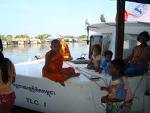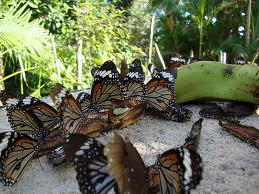The fascinating and glorious details of Cambodia’s culture, cuisine, natural landscape, history and unique life-style that are unfolding in front of us through all the great blogs that my other classmates are posting make it obvious that tourism in Cambodia has a great potential. The country offers rich history and an enchanting culture, mouth-watering cuisine and an uplifting touch of religion. In the recent years expectedly, there has been an increase in the number of tourist arrivals to Cambodia. The number of tourists to Cambodia in the year was more than 2 million in 2007 (foreign visitors).
Like in many other developing countries tourism occupies an important place in the contribution to the economic development of the country. However, we have to be wary of unsustainable tourism practices especially in a culturally, environmentally and economically fragile ecosphere like Cambodia. In a Third World country local communities are vulnerable to the consequences that “mass” international tourism can create.
Sustainable or responsible tourism in the context of developing countries is far deeper than just a buzz word. It touches the lives of some of the poorest of the poor and offers governments and people an opportunity to bring economic empowerment to the common people without compromising or hampering the very assets that brought in the tourists in the first place.
In fact realizing this challenge, the Ministry of Tourism of Cambodia in June 2008 adopted a policy on “ethical/responsible or eco-tourism”. The basis of this national policy of eco-tourism lies on the three drivers of: planet, population, profit. “Eco-tourism must provide the people with additional means of subsistence but also instruct them, allow them to interact and offer, on both sides, an enriching experience.”
Although many NGOs and international bodies were trying to contribute in this field the government’s efforts helped bring together these initiatives under one central body. The organisation called CCBEN or Cambodia Community-based Ecotourism Network operational since 2005, is a non-governmental organisation that has approximately 27 members, mainly local and international ecological NGOs and some private tour operators like “Hanuman Tours”. The role of CCBEN is primarily to train and inform and act as a supportive institution. The CCBEN also helps create an awareness for responsible tourism opportunities in Cambodia.
The three main geographical regions chosen for their high potential in the eco-tourism sector are the North-East provinces (Mondolkiri, Ratanakiri, Stung Treng and Kratie), those in the South-West (region of the Cardamoms chain, mangroves and beaches) and the Tonle Sap basin, particularly around the city of the Angkor temples and Siem Reap, where the Preak Toal reservation. Osmose is an NGO that works here linking conservation and development in the Prek Toal area of the Tonle Sap Lake in Cambodia, north of Siem Reap.
One of the successful projects of CCBEN Prek Toal reservation, on the Tonle Sap, where boat trips co-managed by villagers are offered to tourists and generate a genuine contact with the community installed on the lake. Some of the rangers in charge of the site surveillance are even former poachers! In fact an NGO called the Lake Clinic works here to look after the health of the communities of floating villages
Another highly relevant and visible program based on community tousim is Save the Children, especially aimed at protecting children from abuse and enabling them to access basic healthcare and education. This initiative is active all-around Asia.
Some of the other initiatives are particularly around Siem Reap are:
Banteay Chhmar Community-Based Tourism Site: This site is very close to Siem Reap city. This temple, that’s now partly overgrown by the jungle, originates from the 12th century and was used as a film set for the ‘Tomb raider’ movie. Around the temple, villagers and silk weavers live their traditional way of life.
Banteay Srey Butterfly Centre (BBC) is a social enterprise providing alternative, fair, livelihoods to rural communities in Siem Reap province. Located in Sanday Village on the way to Banteay Srey Temple and the Landmine Museum, BBC has established the largest live butterfly exhibit of its kind in South East Asia. This allows families who are sustainably farming butterflies for the enclosure to be supported by revenue generated from tourist admissions.
Angkor Centre for Conservation of Biodiversity (ACCB), located near the famous temples of Angkor, is the first nature conservation centre in Cambodia. The ACCB aims to contribute to the conservation of wildlife and biodiversity in Cambodia.
Handicap International is another organization that has been working with the Cambodian people since 1982, to provide mine accident survivors with orthopedic devices.
Sam Vaesna Centre organises day trips from Siem Reap and itineraries across Cambodia to see rare birds in their natural habitat at WCS sites. The ecotourism generates income and employment for villagers in remote sites who provide food, accommodation and local guiding for the visitors.
However, community based tourism activity in a developing economy is difficult to implement, mainly because most villagers owing to poor education and resources do not know much about tourism. They usually make their living by hunting in the forest or cutting trees, it is difficult then for an NGO to ask them to stop doing so. Since community tourism initiatives by definition must involve the local people. All such actions have to respect people’s culture and value their rights. Such comes only through persistent effort and training.
We will hopefully get to sample a little of these initiatives during our Master Class!
Let’s all be more responsible and respectful tourists. I will end my post with some tips for responsible tourism. ?
Wildlife and Forest Conservation
• Do not eat, buy, or encourage in any way, wildlife trade and the capture of wildlife. This includes buying of animals out of pity.
• Take all non-biodegradable rubbish out with you as there are no waste management facilities in the villages.
• Try to conserve water.
• Please do not collect plants and specimens from the forest as souvenirs.
Respecting Cultural Values
• Dress modestly. Cover legs and shoulders whilst in the village. Nudity is offensive, so also dress modestly when bathing.
• Take your shoes off when entering a house or your home-stay.
• Don’t become drunk or use drugs. ? ?
• Don’t flirt with local people. Be respectful at all times.
• Please do not give money or gifts to children or beggars.
• Ask before taking photographs of local people.
________________________________________
http://cambodia.ka-set.info/index2.php?option=com_content&do_pdf=1&id=38
http://cambodia.ka-set.info/index2.php?option=com_content&do_pdf=1&id=38
http://www.concertcambodia.org/siem_reap_organisations.aspx
http://www.ccben.org/Going-on-CBET-trip.html



